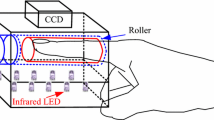Abstract
Finger-vein recognition is an increasingly promising biometric identification technology in terms of its high identification accuracy and prominent security performance. The main challenge faced by finger-vein recognition is the low recognition performance caused by segmentation error and local difference. To tackle this challenge, a finger-vein recognition method with modified binary tree (MBT) model is proposed in this paper. MBT model is used to describe the relationship and spatial structure of vein branches quantitatively. Based on the MBT model, four stages including rough selection, model correction, segment matching, and comprehensive judgment are presented to achieve a robust matching for finger-vein. Experiments demonstrate that the proposed method can boost the performance of finger-vein recognition that is degraded by segmentation error and local difference. While maintaining low complexity, the proposed method achieves 0.12 % equal error rate in the introduced dataset with 8,100 finger-vein images from 150 participants, which outperforms the state-of-the-art methods.






Similar content being viewed by others
References
Hasan H, Abdul-Kareem S (2013) Fingerprint image enhancement and recognition algorithms: a survey. Neural Comput Appl 6:1605–1610
Rubiolo M, Stegmayer G, Milone D (2013) Compressing arrays of classifiers using Volterra-neural network: application to face recognition. Neural Comput Appl 6:1687–1701
Roy K, Bhattacharya P, Suen CY (2011) Towards nonideal iris recognition based on level set method, genetic algorithms and adaptive asymmetrical SVMs. Eng Appl Artif Intell 24:458–475
Wang LY, Leedham G, Cho DSY (2008) Minutiae feature analysis for infrared hand vein pattern biometrics. Pattern Recognit 41:920–929
Kono M, Ueki H, Umemur SI (2002) Near-infrared finger-vein patterns for personal identification. Appl Opt 41:7429–7436
Miura N, Nagasaka A, Miyatake T (2007) Extraction of finger-vein patterns using maximum curvature points in image profiles. IEICE Trans Inf Syst 90(8):1185–1194
Miura N, Nagasaka A, Miyatake T (2004) Feature extraction of finger-vein patterns based on repeated line tracking and its application to personal identification. Mach Vis Appl 15:194–203
Song W, Kim T, Kim HC et al (2011) A finger-vein verification system using mean curvature. Pattern Recogn Lett 32:1541–1547
Qin H, Qin L, Yu C (2011) Region growth-based feature extraction method for finger-vein recognition. Opt Eng 50:57208
Kang BJ, Park KR, Yoo JH (2011) Multimodal biometric method that combines veins, prints, and shape of a finger. Opt Eng 50:17201
Yu CB, Qin HF, Zhang L et al (2009) Finger-vein image recognition combining modified hausdorff distance with minutiae feature matching. J Biomed Sci Eng 2:261–272
Kumar A, Zhou Y (2012) Human identification using finger images. IEEE Trans Image Process 21:2228–2244
Xin Y, Liu Z, Zhang H et al (2012) Finger-vein verification system based on sparse presentation. Appl Opt 51:6252–6258
Liu Z, Yin Y, Wang H et al (2010) Finger-vein recognition with manifold learning. J Netw Comput Appl 33:275–282
Liu Z, Song SL (2012) An embedded real-time finger-vein recognition system for mobile devices. IEEE Trans Consum Electron 58:522–527
Wu JD, Ye SH (2009) Driver identification using finger-vein patterns with radon transform and neural network. Expert Syst Appl 36:5793–5799
Damavandinejadmonfared S, Mobarakeh AK, Suandi SA et al (2012) Evaluate and determine the most appropriate method to identify finger-vein. Proc Eng 41:516–521
Yang JF, Shi YH (2012) Finger-vein ROI localization and vein ridge enhancement. Pattern Recogn Lett 33:1569–1579
Wu JD, Liu CT (2011) Finger-vein pattern identification using SVM and neural network technique. Expert Syst Appl 11:14284–14289
Rosdi BA, Shing CW, Suandi SA (2011) Finger-vein recognition using local line binary pattern. Sensors 11:11357–11371
Yang GP, Xi XM, Yin YL (2012) Finger-vein recognition based on a personalized best bit map. Sensors 12:1738–1757
Yang G, Xi X, Yin Y (2012) Finger-vein recognition based on (2D)2 PCA and metric learning. J Biomed Biotechnol 2012:1–9
Liu T, Xie JB, Lu HZ et al (2013) Finger-vein representation by modified binary tree model. Smart Comput Rev 2:54–61
William KP (2011) Digital image processing, 3rd edn. Wiley, New York
Liu T, Xie JB, Yan W et al (2013) An algorithm for finger-vein segmentation based on modified repeated line tracking. Imaging Sci J 61:491–502
Khalil-Hani M, Nambiar VP, Marsono MN (2012) GA-based parameter tuning in finger-vein biometric embedded systems for information security. In: 1st IEEE international conference on communications in China (ICCC). IEEE, pp 236–241
Jolliffe IT (2002) Principal component analysis, 2nd edn. Springer, New York
Acknowledgments
The research described in this paper has been supported by National Natural Science Foundation of China (Grant No. 61303188) and National Standards Project of China (Grant No. [2012]45).
Author information
Authors and Affiliations
Corresponding author
Rights and permissions
About this article
Cite this article
Liu, T., Xie, J., Yan, W. et al. Finger-vein recognition with modified binary tree model. Neural Comput & Applic 26, 969–977 (2015). https://doi.org/10.1007/s00521-014-1783-x
Received:
Accepted:
Published:
Issue Date:
DOI: https://doi.org/10.1007/s00521-014-1783-x




